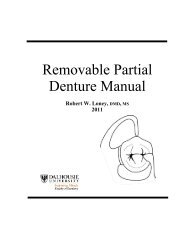Manuals_files/CD Manual 12.pdf - Removable Prosthodontics
Manuals_files/CD Manual 12.pdf - Removable Prosthodontics
Manuals_files/CD Manual 12.pdf - Removable Prosthodontics
You also want an ePaper? Increase the reach of your titles
YUMPU automatically turns print PDFs into web optimized ePapers that Google loves.
Selecting & Setting Teeth - 50<br />
Philosophies of Denture Occlusion:<br />
There are many philosophies of arranging the denture occlusion, but no definitive scientific<br />
studies have proven one type of occlusion to be clearly superior to another. Clinicians<br />
have developed some principals, based on experience, to make it easier to determine which<br />
type of occlusal scheme to use. We will learn two occlusal schemes (there are others):<br />
1. Lingualized Occlusal Scheme<br />
Lingualized occlusion is a type of bilaterally balanced occlusal schemes. The philosophy<br />
of a balanced occlusal scheme is to improve denture stability by maintaining contacts on<br />
both sides of the denture in excursions during function. Patients feel more confident and<br />
have less discomfort when dentures are more stable. There is indirect evidence that<br />
balanced occlusion may reduce ridge resorption and allow for increased functional forces<br />
in excursions. Lingualized occlusion differs from traditional fully balanced schemes by<br />
having only the lingual cusp of the maxillary tooth contacting the mandibular teeth to<br />
maintain this contact.<br />
a) Centric position contacts are set maxillary lingual cusp to fossae of the mandibular<br />
posterior teeth. No anterior contacts should be present in the centric position.<br />
b) Anatomic teeth are used in the maxilla opposing a flat-cusped, or shallow cusped<br />
mandibular tooth.<br />
c) Overbite is incorporated into the anterior setup to improve esthetics, and eccentric<br />
contacts.<br />
d) In eccentric movements there are contacts on both the working and balancing sides<br />
of the denture, whether excursions are protrusive or lateral in nature. Anterior teeth<br />
make grazing contact in excursions.<br />
e) The condylar guidance, incisal guidance, angle of the occlusal plane, cusp angle of<br />
the denture teeth, and compensating curves placed during the posterior tooth setup<br />
all affect the ability to achieve these contacts.















